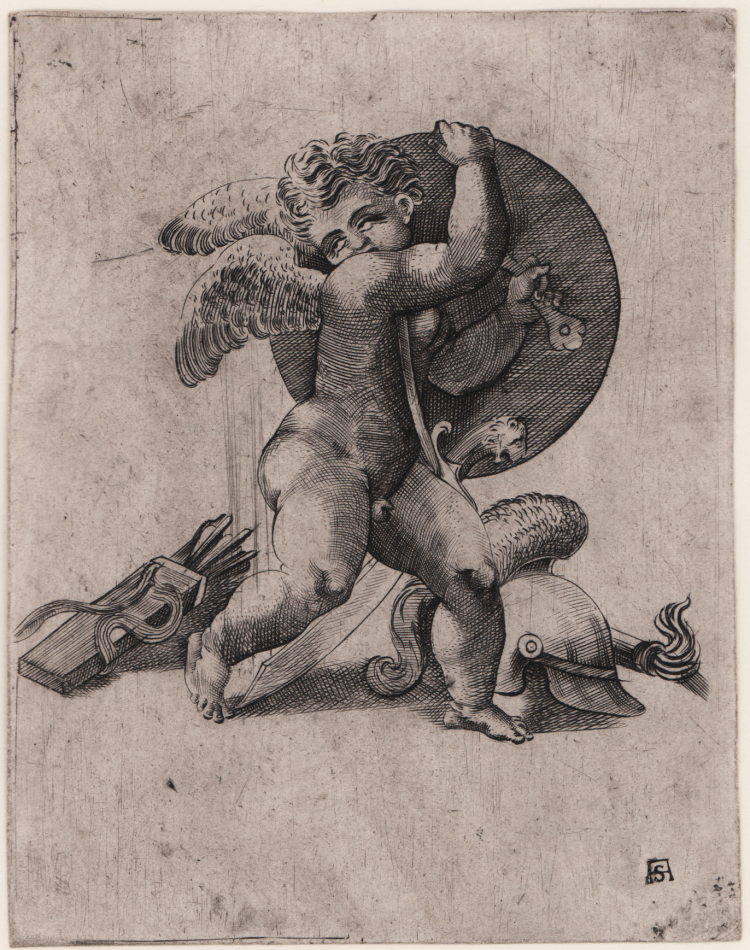



| Reference: | S39979 |
| Author | Adamo SCULTORI |
| Year: | 1550 ca. |
| Measures: | 113 x 144 mm |


| Reference: | S39979 |
| Author | Adamo SCULTORI |
| Year: | 1550 ca. |
| Measures: | 113 x 144 mm |
Engraving, 1547 – 1550 circa, signed lower right with monogram 'AS'.
After Giulio Romano. First state of two.
Good example, printed on contemporary laid paper, with partial watermark, trimmed close to platemark, in good condition.
Accordint to Bellini, the first idea for this composition was suggested by a painted putto on Camino della Scalcheria, Palazzo Ducale, Mantua, which was combined with other influences. Bartsch commented that the print's poor quality suggests it was made by the young Adamo Scultori.
According to Dell’Arco, instead, the composition was a creation by Giulio Romano.
On verso of the platemark is engraved the Virgin nursing the Child.
|
Bartsch, XV, n. 17, p. 422; Bellini, n. 8, p. 46; D’Arco, n. 13, p. 90; Le Blanc, II, n. 92, p. 290; Massari, Incisori Mantovani del Cinquecento, n. 11. p. 28.
|
Adamo SCULTORI (Mantova 1530 circa – Roma 1587)
|
Adamo Sculptor was also called il Mantovano o Ghisi for he was erroneously considered the young brother of Giorgio Ghisi. He was a fine drawer and carver, son of Giovan Battista Scultori and brother of Diana, according to what De Angelis wrote in 1585.
He was an extremely precocious engraver, as attested in the inscription “Adam Sculptor an IX” that can be seen in his father’s Vergine. After Giulio Romano’s death and while Giovan Battista was still alive, Adamo left Mantua to move to Rome. His most famous work is the series of seventy seven engravings depicting the frescoes of Michelangelo’s Sistine Chapel. Together with Giulio Romano, Michelangelo was the artist whose subjects Scultori engraved most; we also know that he appreciated other painters like Sebastiano del Piombo, Nicola Matrinelli and Mantegna.
Scultori was also publisher, as it is witnessed by the plate (kept in the Museum of Calcografia in Rome) engraved by Matteo Greuter with Adamo’s excudit.
Bartsch lists 129 prints under his name, between 1566 and 1577; Passavant 132.
|
|
Bartsch, XV, n. 17, p. 422; Bellini, n. 8, p. 46; D’Arco, n. 13, p. 90; Le Blanc, II, n. 92, p. 290; Massari, Incisori Mantovani del Cinquecento, n. 11. p. 28.
|
Adamo SCULTORI (Mantova 1530 circa – Roma 1587)
|
Adamo Sculptor was also called il Mantovano o Ghisi for he was erroneously considered the young brother of Giorgio Ghisi. He was a fine drawer and carver, son of Giovan Battista Scultori and brother of Diana, according to what De Angelis wrote in 1585.
He was an extremely precocious engraver, as attested in the inscription “Adam Sculptor an IX” that can be seen in his father’s Vergine. After Giulio Romano’s death and while Giovan Battista was still alive, Adamo left Mantua to move to Rome. His most famous work is the series of seventy seven engravings depicting the frescoes of Michelangelo’s Sistine Chapel. Together with Giulio Romano, Michelangelo was the artist whose subjects Scultori engraved most; we also know that he appreciated other painters like Sebastiano del Piombo, Nicola Matrinelli and Mantegna.
Scultori was also publisher, as it is witnessed by the plate (kept in the Museum of Calcografia in Rome) engraved by Matteo Greuter with Adamo’s excudit.
Bartsch lists 129 prints under his name, between 1566 and 1577; Passavant 132.
|